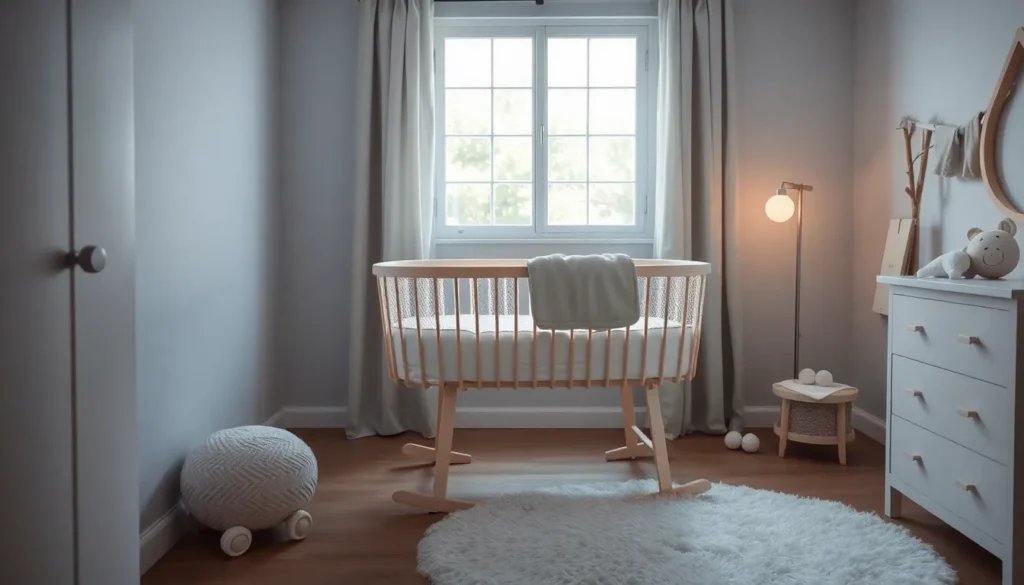Getting a newborn to sleep in a bassinet can feel like trying to teach a cat to fetch—frustrating and often futile. Parents everywhere know the struggle of coaxing their little one into dreamland while secretly wishing for a magic wand. Thankfully, with a few clever tricks up their sleeves, they can turn bedtime battles into peaceful slumbers.
Imagine a world where a soft lullaby and gentle rocking can transform a wide-eyed bundle of energy into a snoozing angel. It’s possible! With the right approach, parents can create a cozy sleep environment that even the fussiest baby would love. Dive into these tips and discover how to make the bassinet the ultimate sleep destination for their little one, ensuring everyone gets the restful night they deserve.
Table of Contents
ToggleCreate a Comfortable Sleep Environment
Creating a cozy sleep environment for a newborn in a bassinet enhances the chances of peaceful nights. This space must be inviting, safe, and conducive to sleep.
Choose the Right Bassinet
Selecting the right bassinet plays a significant role in how comfortably a newborn sleeps. Opt for a model that meets safety standards and offers firm, flat support for the baby. Look for a bassinet with breathable materials, as these help regulate temperature and improve airflow. Bassinets with a gentle rocking feature can also soothe babies, mimicking the motion they felt in the womb. Parents should also consider portability; a lightweight design allows easy movement around the house, ensuring the baby stays close during naps.
Adjust the Room Temperature
Adjusting the room temperature helps create a comfortable sleep environment. Babies generally sleep best in rooms kept between 68°F and 72°F. Maintaining this range reduces the risk of overheating, a serious safety concern. Use lightweight blankets or swaddles to keep the baby warm without compromising comfort. A fan may provide a gentle breeze, aiding in air circulation. Parents can also use a thermometer to monitor the temperature and ensure a consistent environment for the newborn.
Establish a Consistent Sleep Routine

Creating a consistent sleep routine helps newborns feel secure and ready for sleep. Familiarity with their schedule promotes better sleep habits.
Set a Regular Bedtime
Setting a regular bedtime encourages the baby to anticipate sleep. Consistency in the timing, ideally the same time each night, assists the body in adjusting to this rhythm. Newborns thrive on predictability, and having that routine helps signal to them that it is time to wind down. Aim for a window of 7 PM to 8 PM for bedtime, as this aligns with the natural sleep cycle. Gradual adjustments to bedtime can ease the transition as the baby grows.
Incorporate Calming Activities
Incorporating calming activities establishes a peaceful environment for sleep. Soft lullabies or gentle rocking can soothe the baby before bedtime. Establishing a short pre-sleep ritual, such as dimming lights or reading a story, signals that it’s time to relax. Engaging in warm baths can also promote a sense of comfort and calm. Adoption of these calming rituals consistently leads to more restful nights for both the baby and parents.
Use Soothing Techniques
Soothing techniques play a crucial role in helping newborns sleep soundly in their bassinets. These methods can ease anxiety during bedtime.
Swaddling Your Newborn
Swaddling creates a womb-like feeling for newborns. It helps them feel secure and calm, reducing the likelihood of startling awake. Use breathable materials, ensuring the swaddle is snug but not restrictive. Position the baby’s arms gently by the sides, allowing for comfort while maintaining a secure wrap. Consistent swaddling techniques help establish a sleep association, making the bassinet more inviting.
Gentle Rocking or Motion
Gentle rocking or motion promotes relaxation in babies. Soft, rhythmic movements mimic the motions they experienced in the womb. Parents can cradle their newborns or gently rock the bassinet, providing a soothing experience. Utilize slow and smooth motions to prevent overstimulation. Such actions can soothe fussy babies and create a calming atmosphere, encouraging them to settle down for a good night’s sleep. Engaging in this practice fosters peace and comfort, further enhancing the sleeping environment.
Monitor Feeding and Diaper Changes
Monitoring feeding and diaper changes ensures a newborn’s comfort, promoting better sleep in the bassinet.
Timing of Last Feeding
Timing the last feeding before bedtime plays a significant role in helping newborns sleep soundly. Aim for a feeding approximately 30 minutes to an hour before placing the baby in the bassinet. This window allows for burping and settling, reducing the chance of discomfort during sleep. Feeding immediately before sleep may lead to spit-up or fussiness, interrupting rest. Observing the baby’s cues can guide when to feed, ensuring they aren’t overly hungry or too full. Establishing this routine makes sleep more likely, creating a smoother transition to the bassinet.
Keeping the Bassinet Clean and Dry
Keeping the bassinet clean and dry contributes to a safe sleep environment. Regularly check for any spills, leaks, or dirt that may accumulate. Wipe down surfaces with a gentle, safe cleanser to maintain hygiene. Use a waterproof mattress cover to protect against accidents and make cleanup easier. Ensure that bedding is fresh and free from moisture or odors, fostering a pleasant sleeping space. Frequent checks and cleaning can prevent irritation, helping the newborn feel comfortable and secure in the bassinet. Keeping it tidy leads to more restful nights for everyone involved.
Be Patient and Persistent
Patience and persistence are crucial when helping a newborn sleep in a bassinet. Understanding newborn sleep patterns offers valuable insight into their unique needs.
Understanding Newborn Sleep Patterns
Newborns typically sleep for 14 to 17 hours each day, but their sleep cycles are brief, lasting about 50 to 60 minutes. Elements contributing to this include being light sleepers and having shorter REM cycles. Recognizing signs of tiredness can help parents respond promptly. Yawning, fussiness, or rubbing eyes often indicate when the baby is ready for sleep. Assessing these cues allows parents to create a soothing environment that encourages sleep.
Gradual Transition to Bassinet
Gradual transitions can ease the adjustment to sleeping in a bassinet. Start by placing the baby in the bassinet during daytime naps. Providing positive experiences with the bassinet during the day supports longer nighttime sleep. Showcasing comfort is essential; ensure swaddles or sleep sacks promote a sense of security. Consistently using the bassinet for sleep helps establish familiarity, increasing the chances for a smoother transition. Reinforcing this routine with calm activities creates an inviting atmosphere for restful nights.
Establishing a peaceful sleep routine for a newborn in a bassinet can be a rewarding journey. By creating a cozy environment and incorporating soothing techniques parents can foster a sense of security that encourages restful sleep. Consistency is key; regular bedtimes and calming rituals help babies adjust to their new sleeping space.
Monitoring comfort levels through feeding and diaper changes further enhances the experience. With patience and persistence parents can navigate the challenges of newborn sleep patterns. Over time these efforts lead to more serene nights for both baby and parents, making the bassinet a cherished spot for peaceful slumber.



